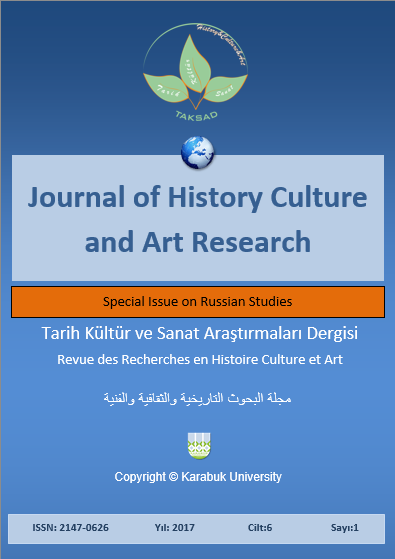Rites of Treatment in Eastern Africa and Rite Vocabulary According to Literary Sources
DOI:
https://doi.org/10.7596/taksad.v6i5.1275Anahtar Kelimeler:
Linguistics- Literature- Rite- Ritual vocabulary- Swahili- Robert Shaaban- Eastern Africa- Translation.Özet
Rites as the reflection of religious ideas and everyday traditions are of great importance to understand the national picture of the world among the representatives of different peoples. The article examines the rites of the East African society aimed at healing; the ritual vocabulary, saturated with national and cultural information is analyzed and the translation decisions in the transfer of cultural-labeled units reflecting the realities of the Swahili culture carriers are demonstrated. Taking into account the nature of the presented material, the methods widely used in historical and ethnographic and philological research were used during the present study: descriptive, systemic, and semantic one. Nowadays, traditional medicine and conventional medicine go hand in hand in Eastern Africa countries, particularly in Tanzania, complementing each other in the treatment and the prevention of diseases, the preservation and the strengthening of human health. In the case when modern medicine is powerless, doctors recommend that patients turn to herbalists. At the same time, it is impossible to confuse healers who use grasses and other natural resources in their work, passing their experience from generation to generation, with sorcerers and the sorcerers not engaged in treatment. The conclusions formulated in the process of research are of practical importance and can be used by the experts of ethnography, ethnology, translation studies, linguistics, cultural studies and historical science, as well as during the lectures on the study of lexicology in Swahili.
Referanslar
Baiburin, A. K. (1993). Ritual in traditional culture: structural and semantic analysis of the Eastern Slavic rites. St. Petersburg: Science.
Dal, V. I. (1881). Explanatory dictionary of the living Great Russian language, Volume 2. Moscow.
Dobronravin, N. A. (2004). Zanzibar Magical Literature (from the collection by N.M. Girenko). Bulletin of St. Petersburg State University. Philology, Oriental studies, Journalism Series, 9(3-4), 115-120.
Gennep, A. (1999). Rites of passage. Systematic study of rituals. Moscow: Eastern Literature Publishing.
Giles, L. (1995). Sociocultural Change and Spirit Possession on the Swahili Coast of East Africa. Anthropological Quarterly, 36, 89-106.
Gromova, N. V.; Myachina, E. N. & Petrenko, N. T. (2012). Swahili-Russian dictionary: 30000 entries. Moscow State University named after M.V. Lomonosov, Institute of Asian and African countries. Moscow: Klyuch.
Kamusi ya Kiswahili Sanifu (2014). Nairobi: Oxford University Press.
Lepeshkina, L. Yu. (2011). Traditional rituals and the rituals of the life cycle in the everyday culture of peoples of the Middle Volga region: 19th - 20th centuries. Thesis from the candidate of historical sciences: 24.00.01. Place of defense: Sarat State Technical University. Togliatti.
Mackenrodt, L. (2011). Swahili Spirit Possession and Islamic Healing in Contemporary Tanzania: The Jinn Fly on Friday. Hamburg: Verlag.
Sedakova, O. (2004). Poetics of the rite: Funeral rites of the Eastern and Southern Slavs. Moscow.
Senkoro, N. (1976). Utamaduni katika Riwaya za Kiswahili. Kiswahili TUKI, 3, 74-80.
Shaaban, R. (1972). Kufikirika. Nairobi: Oxford University Press.
Smirnov, Yu. A. (1990). Morphology of the burial: The experience of a basic model creation. The studies in the field of the Baltic-Slavic spiritual culture: Funeral rite, (pp. 216-224). Moscow.
Kulieva, E. R. (2007). Koran: Translation of meanings (6th ed.). Umma publishing house.
Tokarev, S. A. (1983). Calendar customs and ceremonies in the countries of foreign Europe: Historical roots and the development of customs. Moscow, 1983.
Tolstaya, S. M. (1989). Terminology of rites and beliefs as the source of ancient spiritual culture reconstruction. Slavic and Balkan folklore. Reconstruction of ancient Slavic spiritual culture: Sources and methods, (pp. 215-229). Moscow.
Toporov, V. N. (2005). Studies on etymology and semantics: Theory and some of its particular applications. Moscow: Languages of Slavic Culture.
Turner, V. (1983). Symbol and ritual. Moscow.
Werner, E. (2007). Myths of the Peoples of Africa. Moscow: Tsetrpoligrafr.
CHAWATIATA (2016). Web page, accessed on 17.10.2016, http://chawatiata-tanga.tripod.com/
KIKO (2016). Web page, accessed on 19.11.2016, http://www.africa.uga.edu
İndir
Yayınlanmış
Nasıl Atıf Yapılır
Sayı
Bölüm
Lisans
Tarih Kültür ve Sanat Araştırmaları Dergisi'nde yayımlanan tüm çalışmalar Creative Commons 4.0 CC-BY lisansı ile lisanslanmıştır.
Bunları yapmakta özgürsünüz:
- Bu eseri her boyut ve formatta paylaşabilir — kopyalayabilir ve çoğaltabilirsiniz.
- Materyalden Adapte et — karıştır, aktar ve eserin üzerine inşa et
- her türlü amaç için, ticari amaç da dahil
Alttaki şartlar altında:
Atıf — uygun bilgiyi, lisansa linki, and ve değişiklik yapıldıysa değişiklik bilgisinivermelisiniz. Sizi veya kullanımınızı lisansörün onayladığı bilgisini içermemek kaydıyla, size uygun şekilde bu işlemleri gerçekleştirebilirsiniz.
AynıLisanslaPaylaş — Eğer materyali karıştırdınızsa, aktardınızsa ya da materyalin üzerine çalıştınızsa, ancak aynı lisans ile dağıtabilirsiniz.
- Ek sınırlamalar yoktur — Lisansın izin verdiği hakları başkaları üzerinde kanunlarla ya da teknolojiyikullanarak sınırlayamazsınız.







